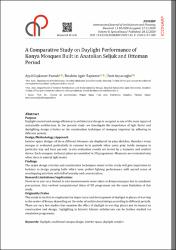Mimar Sinan Güzel Sanatlar Üniversitesi Açık Bilim, Sanat Arşivi
Açık Bilim, Sanat Arşivi, Mimar Sinan Güzel Sanatlar Üniversitesi tarafından doğrudan ve dolaylı olarak yayınlanan; kitap, makale, tez, bildiri, rapor gibi tüm akademik kaynakları uluslararası standartlarda dijital ortamda depolar, Üniversitenin akademik performansını izlemeye aracılık eder, kaynakları uzun süreli saklar ve yayınların etkisini artırmak için telif haklarına uygun olarak Açık Erişime sunar.MSGSÜ'de Ara
A Comparative Study on Daylight Performance of Konya Mosques Built in Anatolian Seljuk a nd Ottoman Period
| dc.contributor.author | Pamuk, Ayşıl Coşkuner | |
| dc.contributor.author | Taştemir, İbrahim Agah | |
| dc.contributor.author | Arpacıoğlu, Ümit | |
| dc.date.accessioned | 2022-06-08T18:31:32Z | |
| dc.date.available | 2022-06-08T18:31:32Z | |
| dc.date.issued | 2020 | |
| dc.identifier.issn | 2147-9380 | |
| dc.identifier.issn | 2147-9380 | |
| dc.identifier.uri | https://app.trdizin.gov.tr/makale/TkRNNE5EVTVPUT09 | |
| dc.identifier.uri | https://hdl.handle.net/20.500.14124/117 | |
| dc.description.abstract | Purpose Daylight control and energy efficiency in architectural design is accepted as one of the main inputs of sustainable architecture. In the present study, we investigate the importance of light factor and daylighting design criterias as the construction technique of mosques improves by adhering to di fferent periods.Design/Methodology/ApproachInterior space designs of three different Mosques are displayed via plan sketches, therefore every mosque is evaluated particularly in summer term periods when users pray inside mosques in particular day and hour periods. In-situ evaluation results are tested by a luxmeter and comfort device. Each mosques’ technical plans are modelled in 3D programme. Measures are evaluated only when there is natural light inside. FindingsThe major design criterias and construction techniques stated in this study will give inspiration to builders to design praying halls which have perfect lighting performance with sacred sense of worshipping activities with full of serenity and concentration.Research Limitations/ImplicationsShort-term and very limited in situ measurements were taken in Konya mosques due to pandemic precautions. Also evolved computational datas of DB programme are the main limitation of this study.Originality/ValueThis study is the first to emphasise the importance and development of daylight in places of worship in the center of Konya, depending on the order of architectural design according to different periods. There are very few studies that examine the effect of daylight in worship places and its impact on construction and design. Daylighting in historic Islamic architecture can be further studied via simulation programme. | en_US |
| dc.language.iso | eng | en_US |
| dc.relation.ispartof | ICONARP International Journal Of Architecture And Planning | en_US |
| dc.rights | info:eu-repo/semantics/openAccess | en_US |
| dc.title | A Comparative Study on Daylight Performance of Konya Mosques Built in Anatolian Seljuk a nd Ottoman Period | en_US |
| dc.type | article | en_US |
| dc.institutionauthor | Arpacıoğlu, Ümit | |
| dc.identifier.volume | 8 | en_US |
| dc.identifier.issue | 3 | en_US |
| dc.identifier.startpage | 102 | en_US |
| dc.identifier.endpage | 123 | en_US |
| dc.relation.publicationcategory | Makale - Ulusal Hakemli Dergi - Kurum Öğretim Elemanı | en_US |
| dc.identifier.trdizinid | TkRNNE5EVTVPUT09 | en_US |
| dc.identifier.trdizinid | 438459 | |
| dc.indekslendigikaynak | TR-Dizin |
Bu öğenin dosyaları:
Bu öğe aşağıdaki koleksiyon(lar)da görünmektedir.
-
TRDizin [1118]
TR Index















